This pork stew is made with pork shoulder, cannellini beans, and a whole bottle of white wine! It's easy to make and perfect on a cold winter's day.
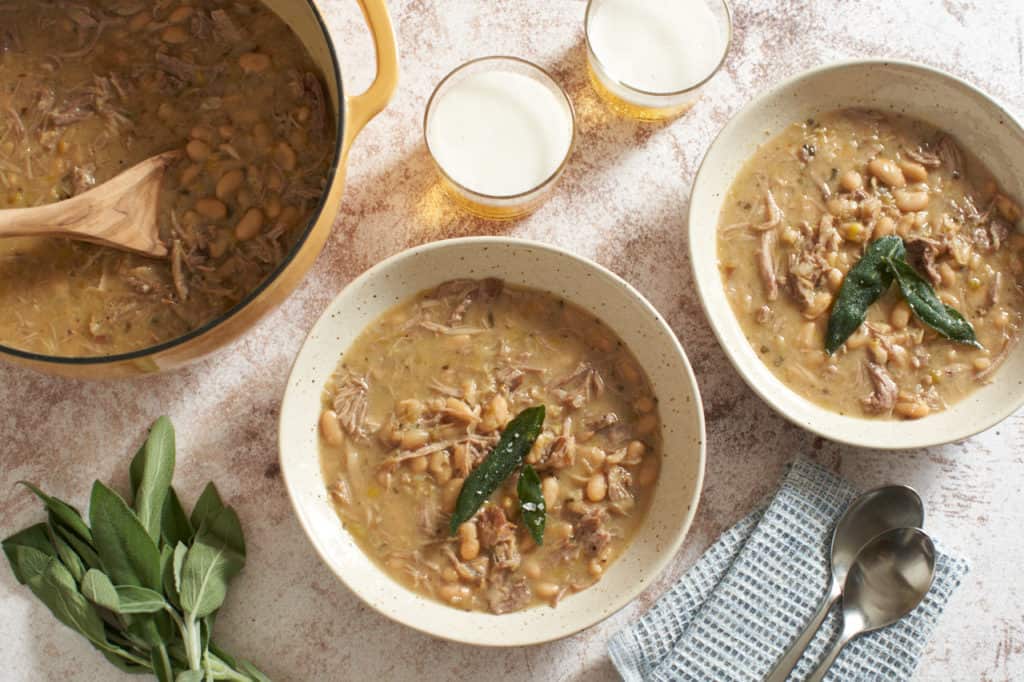
This post contains affiliate links. If you make a purchase through one of my links, I may make a small commission at no additional cost to you. As an Amazon Associate, I earn from qualifying purchases. Read my full disclosure policy here.
Pork stew with white beans is a classic combination and a very homey comfort food. But let's elevate it a bit, shall we? How about we do it by adding wine as the base of the stew??? Yes, let's.
Picture yourself fireside in the French Alps, where the recipe would be made not only with wine, which brings a wonderful acidity and brightness, but also with chic veggies like leeks and shallots. Classy flavors that taste really fancy when they're all put together, creating a stew that is filling without feeling heavy.
You may be surprised to learn there's actually not a lot of effort involved in this fancy-pants pork stew. It's easy to make, just a little slicing and searing and you've done it.
Jump to:
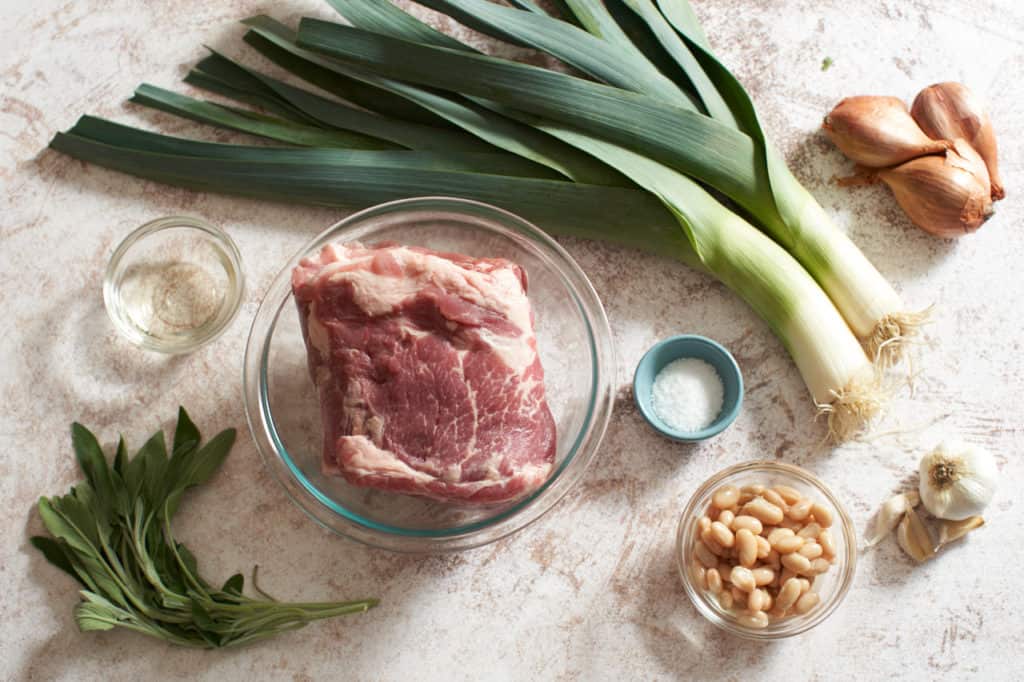
Ingredients you'll need
- Pork shoulder: You can use bonless or bone-in pork shoulder. It's ideal for stew because it must be cooked for a long time to break down the connective tissue. When this happens, you have the most tender meat ever, that you can shred up so it will distribute evenly throughout the stew and you'll have some in every corner of every bite!
- Cannellini beans (canned): I love cannellini beans for their creamy texture. Canned beans means less prep time for you, and we'll use the liquid in the cans to thicken the stew.
- White wine: A light, grassy wine like Savignon Blanc is what I recommend, something like Pinot Grigio would also work well. Don't use a sweet wine like Riesling nor something too buttery like Chardonnay. It doesn't have to be expensive, but the rule of thumb when cooking with wine is to pick something that you would actually drink. If it tastes like vinegar in the glass, it will taste the same in the stew.
- Leeks: Leeks have a mild flavor that pairs well with the pork. Once sautéed, they melt into a wonderful texture. Look for leeks that are nice and white on the bottom and dark green at the top. You don't want them to be too big in diameter, as they tend to get tough and fibrous the larger they are.
- Shallots: Their sweetness complements the wine perfectly. Choose shallots as you would onions, they should be firm and heavy for their size, with no mushy spots or sprouts coming out.
- Garlic: We'll grate the garlic on a microplane grater so it distributes evenly throughout the stew and you aren't biting down on a hunk of garlic. (Sometimes that's fun, but in this recipe, it's not.)
- Sage: There's nothing like fresh sage to add coziness to almost anything. Chopped sage goes into the stew, and if you like, you can fry some sage leaves to add on top.
- Water: For the broth.
- Kosher salt and freshly ground black pepper: To season every layer, the meat, the aromatic veggies, and the wine-based broth.
How to make pork stew
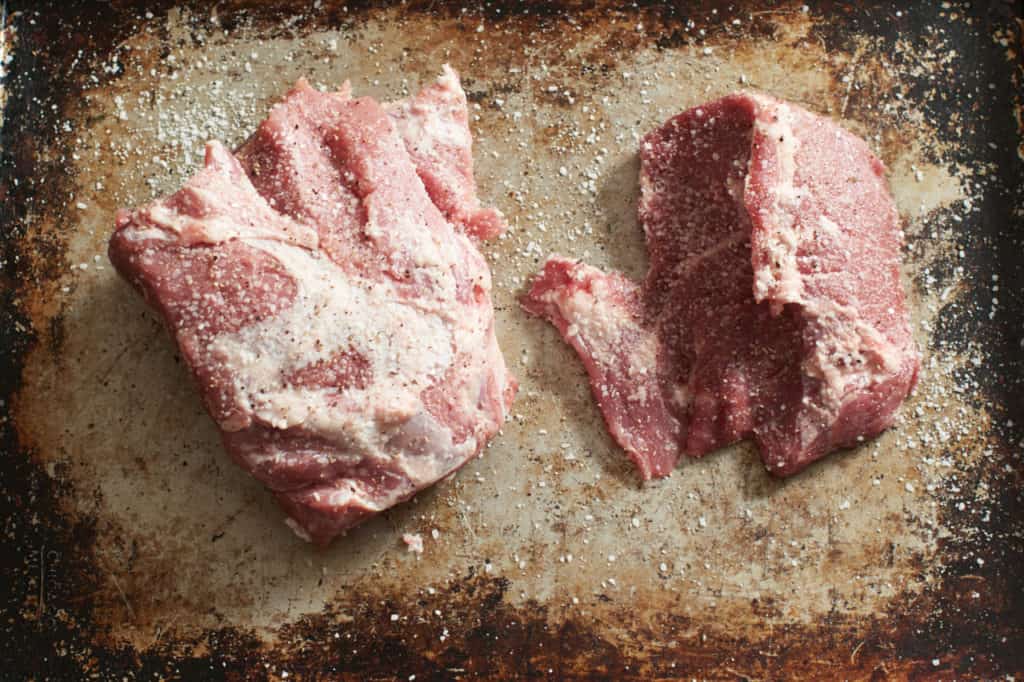
Step 1: Trim and season the pork shoulder
Trim most of the fat cap off the pork, leaving some intact to render in the pot. Cut it into two or three large pieces, season on all sides with salt and pepper. Set aside.
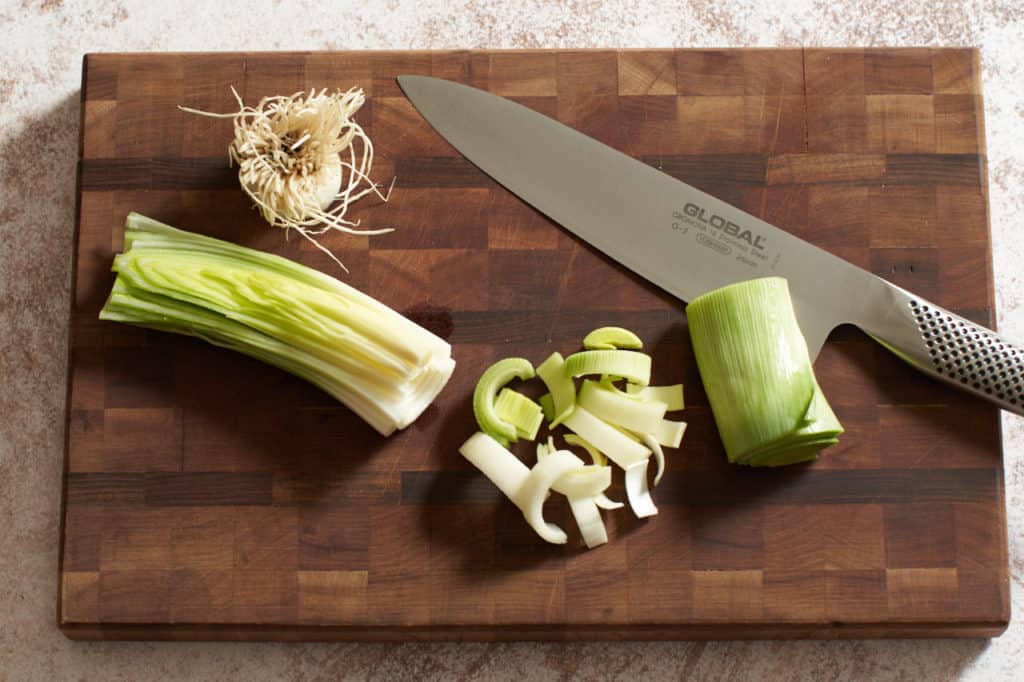
Step 2: Chop the leeks and shallots, grate the garlic
Cut the root ends and the dark green parts off the leeks, then slice in half. Run them under cold water, separating the layers to make sure all sand is washed off. Use a good chef's knife to cut into ½ inch slices.
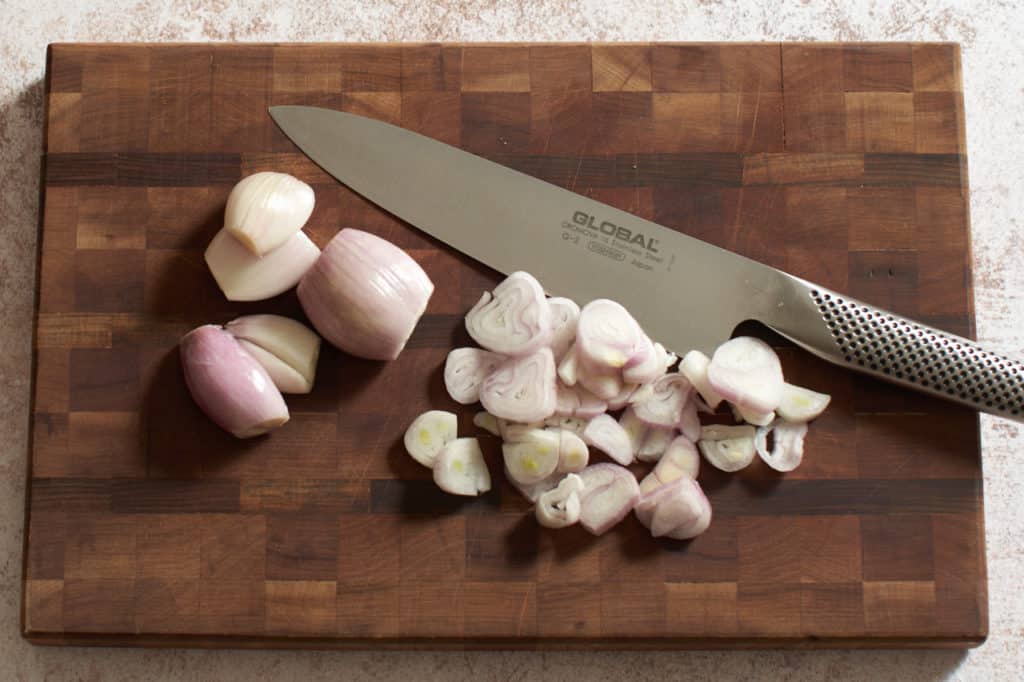
Peel the shallots and slice thinly. I like to leave them in slices because it's easier for prep and then you get carmelized shallot slices throughout the stew, creating wonderful flavor and texture.
Grate the garlic on a microplane grater, chop the sage finely.
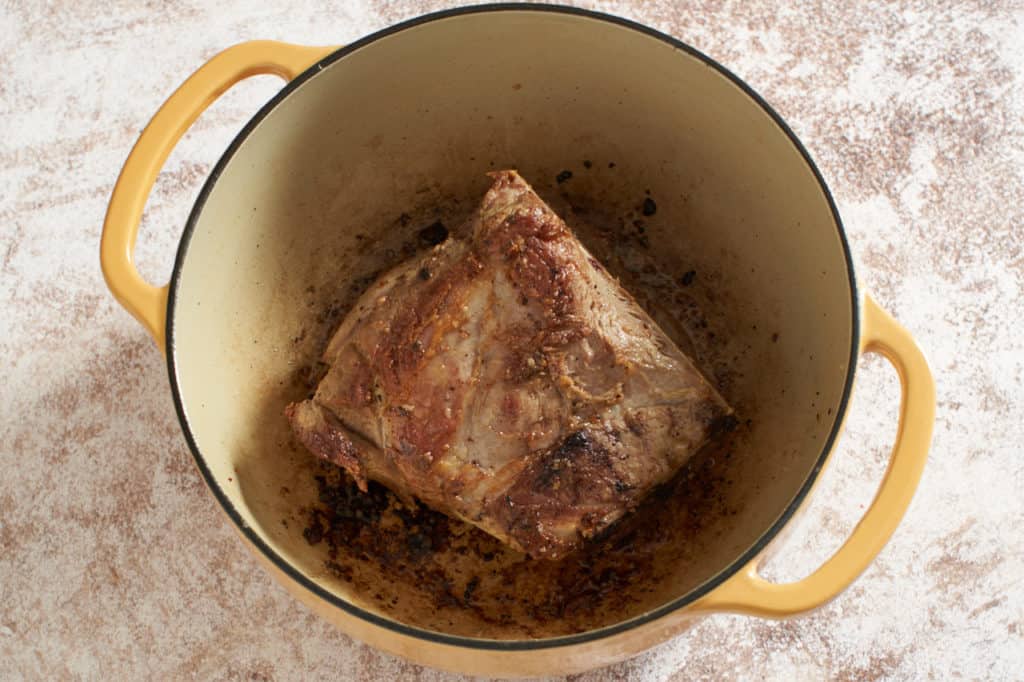
Step 3: Sear the pork shoulder
In a large 6-quart Dutch oven over medium-high heat, sear the pork pieces on all sides until crispy and golden brown. Set aside.
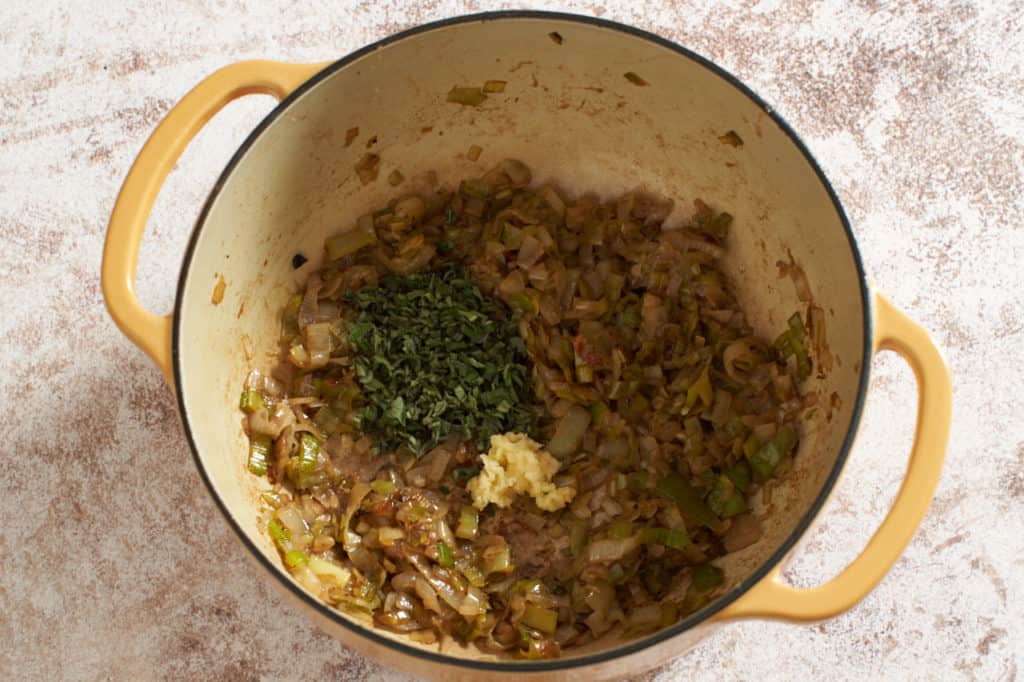
Want to save this recipe?
Step 4: Sauté the veggies, herbs, and garlic
Add shallots and leeks to the rendered fat in the Dutch oven, season with a pinch of salt, stir to scrape up any brown bits on the bottom of the pot. Cook over medium to medium-high heat until they are meltingly soft and starting to caramelize.
Add the grated garlic and chopped sage to the pot, stirring constantly for about 1 minute until fragrant.
Step 5: Add the wine, beans and pork, simmer the stew
Add the whole bottle of wine to the pan, stirring constantly, season with 1 teaspoon of salt. Add all three cans of beans along with their liquid and one cup of water and stir to combine. Add the pork and its resting juices back into the pan and bring to a simmer over medium heat.
Once simmering, turn heat to low, cover and cook for 2 - 2 ½ hours, until pork is falling apart.
Step 6: Pull (shred) the pork and return to the stew
Remove pork from the pot and continue to simmer uncovered to allow the stew to thicken to your desired consistency, 15-30 minutes.
Carefully shred the pork with your hands (careful, it's HOT) or use two forks, then add it back into the stew. Cook for about 5 minutes until the pork is heated through, then serve.
Step 7: Fry the sage leaves
While the stew is simmering, you can fry sage leaves to put on top. Use a small shallow skillet, pour in olive oil until it just covers the bottom and heat over medium until shimmering. Add sage leaves and fry for about 30 seconds, then remove to a paper towel and season with sea salt while still hot.

Tips for the best pork stew
- If you buy bone-in pork shoulder, you'll need to get about ½ pound more to account for the weight of the bone.
- You'll need a large Dutch oven, at least 6-quart capacity. This is a big pot of stew!
- Don't throw out the liquid in the canned beans! Add it to the pot to be part of the 'stock'. It adds flavor and thickens the stew.
- The easiest way to pull the pork is to use your hands, but CAREFULLY because the meat will still be HOT! You can also use two forks and shred it that way before putting it back into the stew. As you stir, the pork will continue to shred and break down.
- This is a pretty thick stew. If you prefer a soupier consistency, add more water.
- Be careful when frying the sage leaves. They are full of water and will sizzle and pop a lot when they hit the oil.
- You can substitute navy beans or great northern beans for the cannellini beans if you prefer.
- Serve with white wine, of course, or a pilsner beer for that aprés ski feel.
Make ahead and reheating instructions
- You can season the pork one day ahead and leave it overnight in the fridge if you like.
- Make this stew up to 3 days ahead: It will taste even better the longer it sits!
- To reheat leftovers, place over medium heat until the stew comes to a simmer, you may need to add more water if it has thickened considerably.
FAQ
Pork shoulder is best for stew because it needs to be cooked a long time. It will get better and better the longer it cooks, as the connective tissues break down in the meat, until it's so tender it will shred easily. Do not use pork loin or pork tenderloin as they do not have much fat and will be tough.
If you're using pork shoulder and it's still tough, then it hasn't cooked long enough. You'll know it's done when it easily shreds and breaks apart and is falling off the bone. If you can't easily separate a chunk and shred it, cook it longer.
Yes, pork stew freezes well for up to 3 months in an airtight container. Thaw in the fridge before reheating.
More recipes with white beans
Cannellini beans are one of my favorite ingredients. They can be part of a light meal or a great addition to something hearty.
- Tuscan White Bean Soup is light and seasoned with sage and rosemary. A parmesan rind simmering in the broth is the secret to this umami-rich broth.
- Easy White Chicken Chili puts a twist on your old favorite and gets smoky flavor from roasted poblano peppers.
- Italian Sausage with Cannellini Beans is a Sunday Supper that any Italian grandmother would love.
Pork stew that's homey, comforting, and easy to make!
- We'll use pork shoulder for this stew, an economical cut that will break down and just get better and more tender as it cooks.
- Thick and hearty, it's a stick-to-your ribs meal on a cold day.
- It's gluten free and dairy free!
- Easy prep: Just sear the pork and chop a few things, then let the magic happen as it cooks.
Recipe
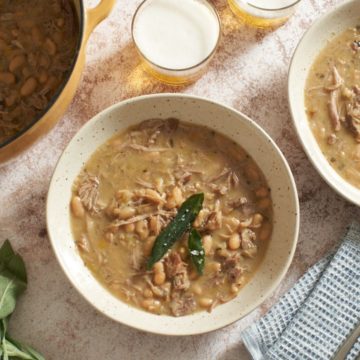
Pork Stew with White Beans, Wine, and Sage
Want to save this recipe?
Ingredients
- 2.5 pounds boneless pork shoulder or 3 pounds bone-in pork shoulder
- 3 cans cannellini beans 15 ounces each
- 3 leeks
- 5 shallots
- 3 cloves garlic
- 2 tablespoon chopped fresh sage
- 1 bottle sauvignon blanc white wine (750 ml)
- 1 cup water
- kosher salt and black pepper
Fried Sage Leaves (optional)
- olive oil enough to cover bottom of pan
- fresh sage leaves
- sea salt
Instructions
- Trim most of the fat cap off the pork, leaving some intact to render in the pot. Cut it into two or three large pieces, season on all sides with salt and pepper. Set aside.
- Cut the root ends and the dark green parts off the leeks, then slice in half. Run them under cold water, separating the layers to make sure all sand is washed off. Use a good chef's knife to cut into ½ inch slices.
- Peel the shallots and slice thinly. I like to leave them in slices because it's easier for prep and then you get carmelized shallot slices throughout the stew, creating wonderful flavor and texture.
- Grate the garlic on a microplane grater, chop the sage finely.
- In a large 6-quart Dutch oven over medium-high heat, sear the pork pieces on all sides until crispy and golden brown. Set aside.
- Add shallots and leeks to the rendered fat in the Dutch oven, season with a pinch of salt, stir to scrape up any brown bits on the bottom of the pot. Cook over medium to medium-high heat until they are meltingly soft and starting to caramelize, 8-10 minutes.
- Add the grated garlic and chopped sage to the pot, stirring constantly for about 1 minute until fragrant.
- Add the whole bottle of wine to the pan, stirring constantly, season with 1 teaspoon of salt. Add all three cans of beans along with their liquid and the cup of water and stir to combine.
- Add the pork and its resting juices back into the pan and bring to a simmer over medium heat. Once simmering, turn heat to low, cover and cook for 2 - 2 ½ hours, until pork is falling apart.
- Remove pork from the pot and continue to simmer the stew uncovered until it thickens to your desired consistency, 15-30 minutes.
- Using your hands (CAREFULLY, it is still VERY HOT) or two forks, shred the pork and add it back into the stew. Cook for about 5 minutes until the pork is heated through, adjust seasoning if needed, then serve.
Frying the sage leaves
- While the stew is simmering, you can fry sage leaves to put on top. Use a small shallow skillet, pour in olive oil until it just covers the bottom and heat over medium until shimmering. Add sage leaves and fry for about 30 seconds, then remove to a paper towel to drain and season with sea salt while still hot.
Notes
- Don't throw out the liquid in the canned beans! Add it to the pot to be part of the 'stock'. It adds flavor and thickens the stew.
- The easiest way to pull the pork is to use your hands, but CAREFULLY because the meat will still be HOT! You can also use two forks and shred it that way before putting it back into the stew. As you stir, the pork will continue to shred and break down.
- If you prefer, you can use canned navy or great northern beans.
- Add more water if you find the stew too thick.
- This stew freezes well for up to three months. Thaw in the refrigerator before reheating.
- Be sure to read the post above for tips on choosing ingredients, more tips and FAQs.

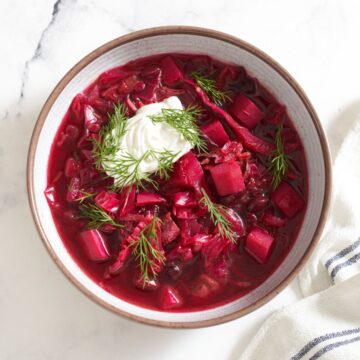
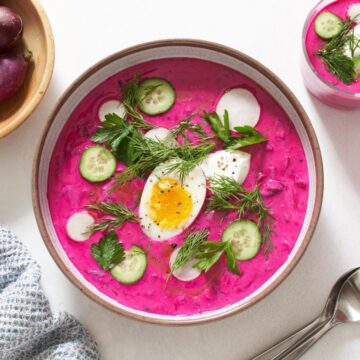

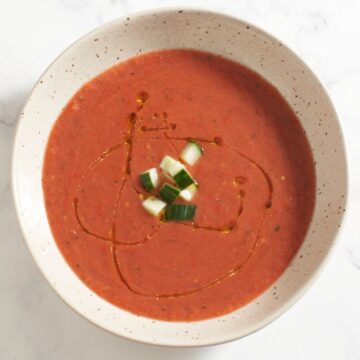
Leave a Reply